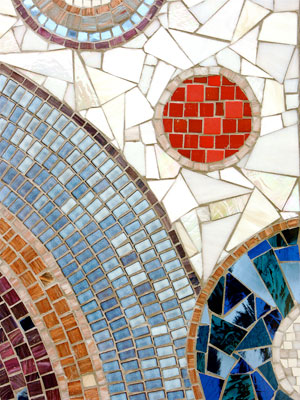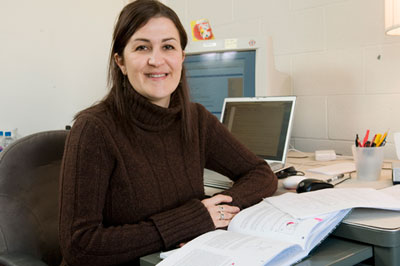
Mosiac Title: No1 beginnning, click for copyright information.
When you stand back to admire a mosaic, such as the one to the left, you see the overall image. But look closely, and you can see the individual tiles and binding mortar that make up the mosaic.
Physicists do much the same thing when they study protons and neutrons.
Crack open a proton or a neutron, and you'll find quarks swarming around inside. Among the quarks are a host of other particles called gluons, which glue the quarks together so tightly that no quark can ever be found alone.
These quarks and gluons can be thought of as the tiles and mortar that make up a mosaic, with the entire mosaic itself resembling a proton or neutron (protons and neutrons are also called nucleons).
Probing Nucleons
Nucleons are probed at Jefferson Lab with the CEBAF electron accelerator, which sends electrons crashing into nucleons. For high-resolution studies, very energetic, high-energy electrons are crashed into the nucleons. Lower resolution studies are conducted with less energetic electrons.
When a nucleon is probed at high energies, the quarks appear as almost free -- "quasi-free" -- of the force that binds them. On the other hand, when probed with lower energies, quarks are strongly bound, vigorously interacting with each other to form excited states of the nucleon known as nucleon resonances.
Interestingly, however, when scientists probe nucleons at energies where nucleon resonances are prevalent, these complex systems can sometimes behave as if they were just a collection of "quasi-free" quarks. That is, all the effects due to the interactions between quarks seem to cancel on average. This odd phenomenon is called quark-hadron duality.
According to Patricia Solvignon, a postdoctoral appointee at Argonne National Lab, finding where protons and neutrons exhibit behavior similar to "quasi-free" quarks can help scientists understand the complicated structure of our universe found at the heart of matter.

Patricia Solvignon worked on the experiment as a Ph.D. student from Temple University. She's now a postdoctoral appointee at Argonne National Lab.
Quark-Hadron Duality Under the Microscope
Previous measurements of quark-hadron duality in the proton found that there are discrete distances where views of the proton bear a remarkable resemblance to views of quasi-free quarks.
Nilanga Liyanage, an associate professor at University of Virginia, and his colleagues decided to test if the same was true for the neutron. The experiment was carried out in Jefferson Lab's Hall A.
The neutrons they probed were polarized - mostly spinning in one direction. The measurement was made possible by a peculiarity of helium atoms.
"Helium-3 is composed of one neutron and two protons. When you polarize the helium-three atom, the two protons have an opposite spin, and that means they cancel each other. So the spin of the helium-3 is carried by the neutron," Solvignon says.
The spinning neutrons were probed at several distances in the resonance region.
"You are probing the quarks, but the quarks are tied together, interacting with other quarks and gluons. You are probing a quark with all the interactions that come with it," Solvignon explains.
Even so, when scientists probe deeply enough, these quarks appear to be "quasi-free" of the force that binds them so tightly. Their probes of the neutron revealed that the neutron behaved similarly to these "quasi-free" quarks.
"The measurement looks like, on average, that you are looking at a collection of quasi-free quarks itself. This is very surprising, because you are not expecting to see this mess acting like a single quark," she says.
Solvignon says the experimenters also found at what distance this behavior starts. She says this similarity can come in handy for helping scientists to understand the strong force that binds quarks together into protons and neutrons. This force is somewhat understood at distance scales where quarks exhibit "quasi-free" behavior. But it is still quite mysterious when it comes to how it binds quarks at the distance scale of protons and neutrons.
"If theories can reproduce this quark-hadron duality, they would be on a very good path to the understanding of theory for the strong interaction. So this is one reason why quark-hadron duality is so important."
This was the first measurement of duality on the spin structure of the neutron. The result was published in the Oct. 31 edition of Physical Review Letters.
Technical Paper
Quark-Hadron Duality in Neutron (3He) Spin Structure
P. Solvignon et al. (Jefferson Lab E01-012 Collaboration)

